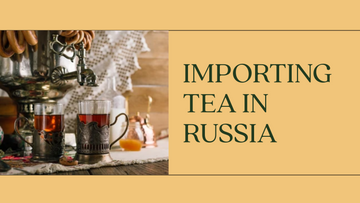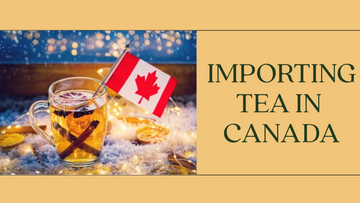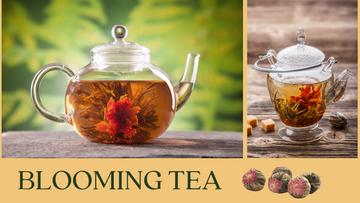
Importing Teas from India: A Beginner's Guide
India is famous for its tea, and it's no surprise that many tea lovers are interested in importing Indian tea. With so many varieties available, it can be overwhelming for beginners to understand the Indian tea industry and how to start their own import business. In this blog post, we will cover everything you need to know about importing teas from India. From understanding the different types of Indian teas and major producing regions to exploring the essential steps required for starting a tea import business. We will also discuss the documentation required and legal regulations needed for compliance with importing tea from India. Lastly, we will touch upon any challenges that arise when importing teas from India, along with how the Tea Board of India can help new importers.
Understanding the Indian Tea Industry
India, one of the largest tea exporters globally, plays a vital role in the country's economy through its thriving tea industry. Tea production is concentrated in various regions across India, creating employment opportunities for thousands of workers. The demand for Indian tea remains high both domestically and internationally. This industry encompasses a wide range of tea types, including herbal tea, white tea, black tea, and more. While India takes pride in its tea exports, it faces competition from countries like China, Kenya, Sri Lanka, and Bangladesh. Nonetheless, in the previous financial year, India managed to maintain its position as a leading tea exporter. July to April is the peak season for tea exports, with European countries, the United States, Russia, and the Middle East being major importers. With its rich tea heritage and diverse offerings, India continues to make a significant impact on the global tea market.
Major Tea Producing Regions in India
India is home to several major tea-producing regions, with West Bengal and Assam leading the way. In West Bengal, the Darjeeling district is renowned for its unique and flavorful Darjeeling tea. This tea is highly sought after for its distinct taste, which is a result of the region's high altitude and cool climate. On the other hand, Assam tea is known for its strong, malty flavor that tea enthusiasts appreciate. Apart from West Bengal and Assam, other regions such as Himachal Pradesh and Tamil Nadu also contribute to the tea production in India. Each of these regions has its own distinct characteristics and flavor profiles, adding to the diverse range of teas that India produces.
The Variety of Indian Teas for Export
India offers a diverse range of teas for export, encompassing green, black, and oolong varieties. Green tea, known for its numerous health benefits, is gaining popularity worldwide. Black tea, on the other hand, is the most commonly consumed type of tea in India and is exported to various countries. Oolong tea, with its partially fermented leaves, boasts a unique flavor profile that sets it apart from other types of tea. Each variety of Indian tea has its own distinct characteristics and flavors, making them sought after in the global market. From the refreshing and delicate notes of green tea to the robust and flavorful black tea, Indian teas cater to a wide range of consumer preferences.
Green, Black, and Oolong: Exploring the Different Types of Indian Tea
When it comes to Indian tea, there are three main types that you should explore: green tea, black tea, and oolong tea. Green tea is known for undergoing minimal oxidation, which allows it to retain its natural color and flavor. On the other hand, black tea goes through full oxidation, resulting in a bold and robust flavor profile. Oolong tea stands in between, as it is only partially oxidized, offering a balance between the freshness of green tea and the richness of black tea.
Indian green tea, in particular, is highly regarded for its freshness and antioxidant properties. Each type of tea offers a diverse range of flavors and aromas, making the exploration of Indian tea an exciting journey. From the delicate notes of green tea to the boldness of black tea and the unique character of oolong tea, there is something for every tea lover to enjoy. Explore the different types of Indian tea and discover your own favorite flavors and aromas.
Major Importing Countries for Indian Tea
Germany stands out as one of the largest importers of Indian tea, reflecting its robust demand for this aromatic beverage. The UK, known for its longstanding tradition of tea consumption, also imports Indian tea to cater to its tea-loving population. Japan, with its discerning taste buds and appreciation for high-quality teas, brings in Indian tea to satisfy its tea connoisseurs. Additionally, Canada, the US, and Australia emerge as major importers of Indian tea, further solidifying the global reach of this sought-after product. It's worth noting that Indian tea finds its way into various countries across the globe, showcasing the widespread popularity and demand for its distinct flavors and aromas.
How to Start Your Own Tea Import Business?
Starting your own tea import business involves thorough market research and understanding of the tea industry. Building strong relationships with Indian tea exporters is crucial for success. Make sure to familiarize yourself with import regulations and customs procedures. Develop a comprehensive business plan, secure financing, and focus on marketing and promoting your imported teas to attract customers.
Essential Steps to Importing Tea from India
To successfully import tea from India, it is essential to follow a few key steps. The first step is to thoroughly research and identify reliable Indian tea suppliers. This ensures that you are working with reputable producers who can provide high-quality tea.
Once you have chosen your suppliers, the next step is to obtain the necessary import licenses and permits. This ensures that you are compliant with all legal requirements and regulations when bringing the tea into your country.
Arranging transportation and logistics is another crucial step in the importing process. This includes finding reliable shipping partners who can handle the transportation of the tea from India to your desired destination.
Importing tea also requires strict adherence to quality and safety standards. It is important to ensure that the tea meets all the necessary standards and certifications for consumption.
Lastly, developing a strong supplier-customer relationship is key for long-term success. Building trust and open communication with your suppliers will help foster a mutually beneficial partnership.
By following these essential steps, you can navigate the process of importing tea from India smoothly and effectively.
Documentation Required for Importing Indian Tea
Importing Indian tea necessitates specific documentation to ensure a smooth import process. This includes invoices and packing lists that detail the tea being imported. Additionally, a Bill of Lading or Airway Bill is essential for transportation purposes. To verify the quality and safety of the tea, phytosanitary certificates may be required. These certificates confirm that the tea meets the necessary standards. Furthermore, importers may need to provide proof of origin to facilitate customs clearance. Proper documentation plays a critical role in streamlining the import process and ensuring that all legal requirements are met. By adhering to these documentation requirements, importers can successfully import Indian tea without any complications.
Understanding the Legalities: Regulations and Compliance for Importing Tea
Importing tea involves adhering to various regulations and compliance requirements. Countries may impose tariffs and duties on imported tea, which can affect import costs. In some cases, prior notice of tea imports may be required by certain countries to ensure smooth customs clearance. Meeting import regulations often requires quality assurance measures and testing to ensure the safety and quality of the tea being imported. It is crucial for importers to familiarize themselves with international trade laws to ensure compliance and avoid legal issues. By understanding and following the legalities surrounding tea importation, importers can navigate the process more effectively and establish a successful tea import business.
Role of the Tea Board of India in Exports
The Tea Board of India plays a crucial role in promoting Indian tea exports. By providing support and assistance to tea growers and exporters, it helps in ensuring the success of the industry. The board also ensures compliance with quality standards and certification requirements, thereby maintaining the reputation of Indian teas in the global market. In addition, the Tea Board represents the Indian tea industry in international trade negotiations, advocating for favorable policies and opportunities. By doing so, it contributes to improving the competitiveness of Indian tea worldwide. With the Tea Board's assistance, Indian tea can continue to thrive and make its mark in the international tea trade.
How Can the Tea Board of India Help New Importers?
The Tea Board of India offers valuable assistance to new importers of Indian tea. They provide guidance on the best quality teas, regulations and procedures for importing, and can help with licenses and certifications. Utilizing their resources ensures a smoother importing process.
Are there Any Challenges in Importing Teas from India?
Importing teas from India does come with its challenges. Navigating complex import regulations and paperwork can be a hurdle. Ensuring consistent quality across batches can also be difficult. However, working with a reputable supplier and importer can help mitigate these challenges.
Conclusion
Importing teas from India can be a lucrative business opportunity for tea enthusiasts. With its rich history and diverse range of tea varieties, India offers a wide selection of high-quality teas for export. However, starting an import business requires careful planning and understanding of the Indian tea industry, as well as knowledge of the documentation required for importing.
By exploring the different types of Indian tea and familiarizing yourself with the major tea producing regions, you can choose the best teas to import based on the preferences of your target market. Additionally, it is important to research the major importing countries for Indian tea to identify potential buyers and establish strong business relationships.
While there may be challenges in the importing process, such as complying with regulations and ensuring quality control, the Tea Board of India can provide valuable support and guidance to new importers. By following the essential steps and obtaining the necessary documentation, you can navigate the process successfully and establish a thriving tea import business.
In conclusion, importing teas from India offers a world of possibilities for tea lovers and entrepreneurs. With its diverse range of flavorful teas and the support of the Tea Board of India, you can embark on a rewarding journey of sharing the rich tradition of Indian tea with consumers worldwide.




